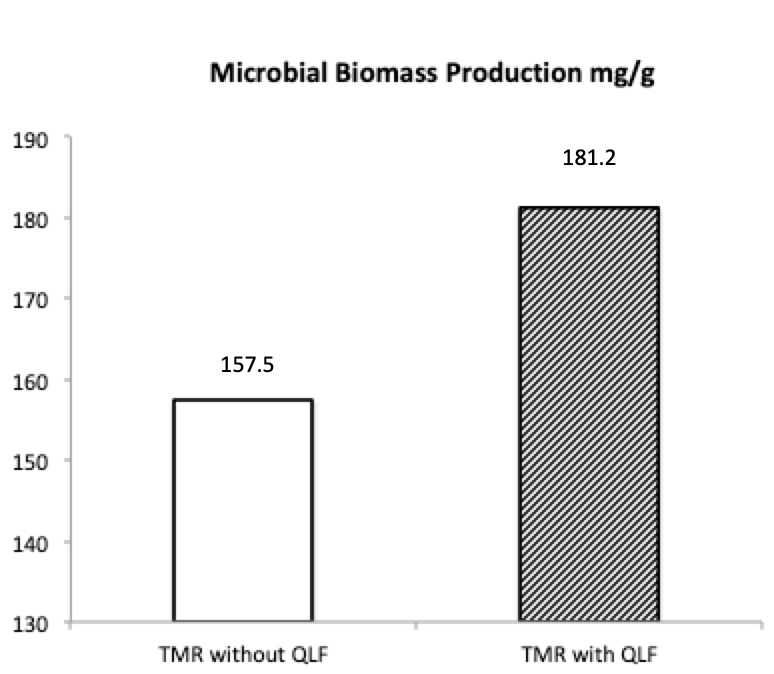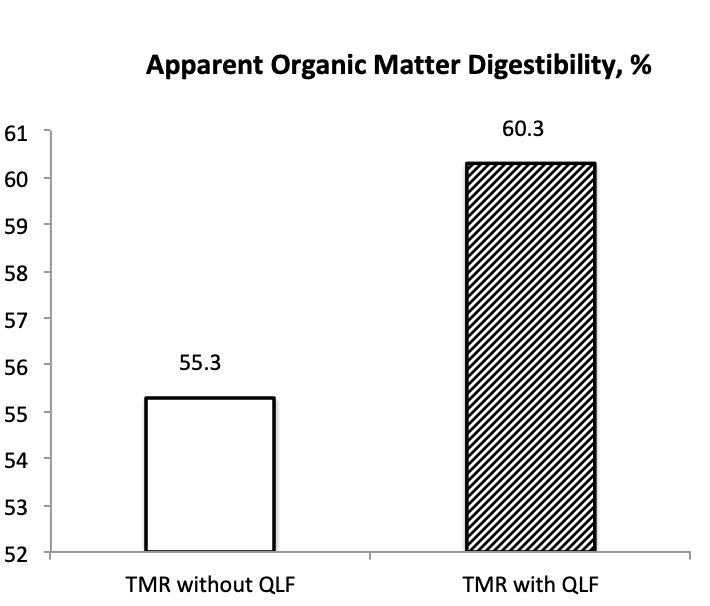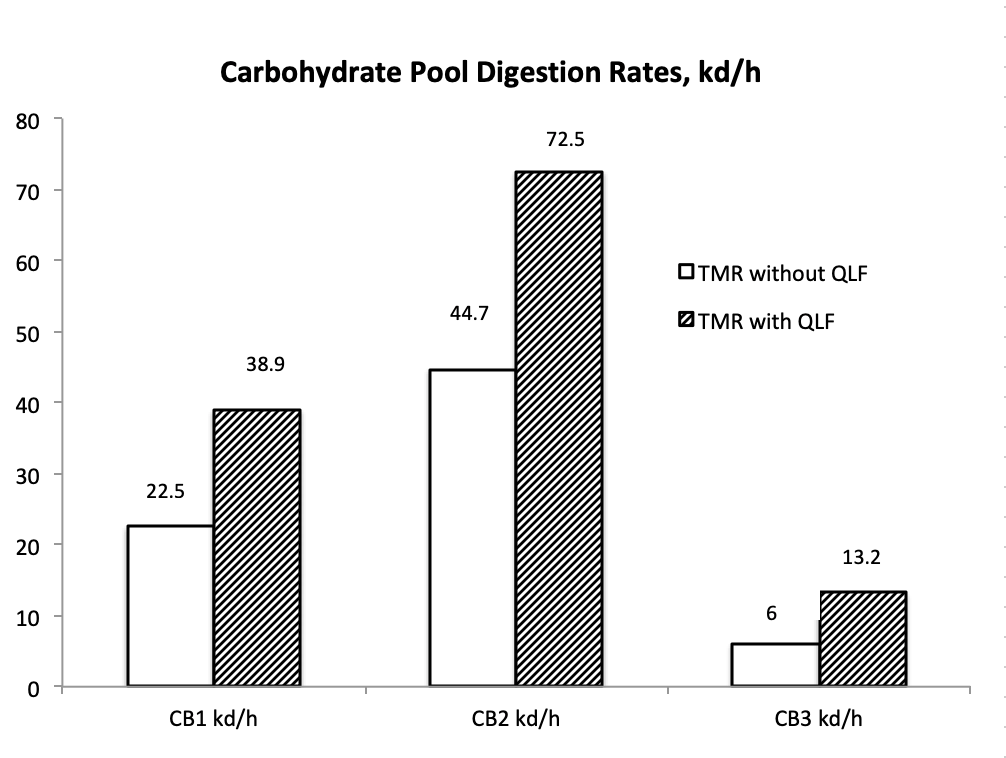Kai Yuan, PhD
QLF Senior Technical Advisor & Senior Scientist
Molasses-based liquid supplements are known to enhance rumen fermentation and milk components by driving ruminal microbial growth and fiber digestion. A novel TMR fermentation system called Fermentrics™ Technology is a useful tool to help demonstrate feed fermentation kinetics. By using this technology, we showed improved TMR digestion and fermentation from TMR supplemented with QLF.
What is Fermentrics™?
Fermentrics™ is a novel gas fermentation system of TMR or feedstuffs using rumen fluids. By using unique analytical methods, this system can distinguish fast and slow fermenting carbohydrate pools in feed samples, showing the dynamics of feed digestion. This technology can measure gas production, microbial growth, microbial biomass, organic matter digestibility, and the digestion rate of different carbohydrate pools during the 48-hour period. It is a useful tool to help nutritionists and producers evaluate TMR fermentation patterns and make ration adjustments.
TMR sampling
A dairy farm in WI with average milk production at 90 lbs/d was used in this study. The farm was supplemented with a product called QLF Optimizer Base 15 at 2.75 lbs/h/d as-fed. This product delivers protein, sugars, lactating cow vitamins and minerals through a molasses-based liquid supplement. Two TMR samples were taken at the farm: one sample was taken without QLF was supplemented in the diet, and anther sample was taken with QLF was supplemented in the diet. The forage types in this diet are corn silage, haylage, and oatlage. Both rations had similar levels of dry matter, CP, energy, NDF, and starch. With the addition of QLF product, dietary sugar level increased by 0.72 lb/h/d. Nutrients provided by the QLF were not replaced by other feeds in the diet. The nutrient specs for both diets are shown in Table 1. Both TMR samples were collected on-farm and then sent to Dairyland Laboratories (Arcadia, WI) for analyses of Fermentrics™.
Table 1: Nutrient analyses of TMR samples (dry matter basis).
| Nutrient | TMR Without QLF | TMR with QLF |
| DM, % | 49.2 | 50.7 |
| CP, % | 18.9 | 19.3 |
| SP, % CP | 38.2 | 37.5 |
| NDF, % | 27.1 | 26.3 |
| NEL, Mcal/lb | 0.77 | 0.77 |
| Starch, % | 26.2 | 26.0 |
| Sugar, % | 3.8 | 4.9 |
| Starch + Sugar, % | 30.0 | 30.9 |
Please note the ration sugar level before supplementing QLF was 3.8%, and after supplementing QLF is 4.9%. This level of sugar is lower than the 7% optimal sugar level recommended by current research. Despite small increase in sugar level, we still detected major improvements in rumen fermentation as shown in the “Results” section below.
Fermentrics™ Results
Despite a small increase of dietary sugar level from 3.8% to 4.9% by supplementing a QLF lactating cow VTM product, we found large improvements in microbial production, organic matter digestion, and carbohydrate digestion rates. The details are shown in figures below.

Microbial Biomass Production
According to the definition provided by Dairyland Lab, microbial biomass production (mg/g) is “measured directly by analyzing the substrate that remains after 48 h incubation with a NDF analysis”. TMR supplemented with QLF had a 15% increase (181.2 vs. 157.5 mg/g TMR) in microbial production. The equation below can be used to estimate rumen microbial protein production using the value of microbial biomass production.
Rumen microbial protein (g) = microbial biomass production x 0.41 x 1.3 x DMI (kg)
Using this equation and a DMI of 25 kg/d, the estimated rumen microbial protein production is 2414 g for TMR with QLF and 2099 g for TMR without QLF. What is the value of an additional 315 grams of microbial protein? If we just use the price of fishmeal at $1500/ton as an estimate (by the way, microbial protein is worth more than fishmeal due to its superior quality and digestibility), the additional microbial protein contribution (315 g) from supplementing QLF equates to 52 cents/h/d.

Apparent Organic Matter Digestibility
This measures the percent of organic matter digested in the TMR sample. TMR supplemented with QLF had a 9% increase (60.3 vs. 55.3% DM) in apparent organic matter digestibility, suggesting better utilization of TMR.

Fast Pool kd/h
This measures the degradation rate of silage acids, sugars, rapidly degradable starch and soluble fiber. TMR supplemented with QLF had a 62% increase (72.5 vs. 44.7 kd/h) in fast pool digestion rate. Sugars are rapidly fermented in the rumen, and the addition of dietary fermentable sugar contributed to the digestion of fast pool.

CB1, B2 and CB3 kd/h
These are the digestion rate of carbohydrate pools B1 (starch), B2 (soluble fiber) and B3 (NDF). Inclusion of QLF increased the digestion rate of all carbohydrate pools. The digestion rate of CB3 (NDF) increased from 6 to 13.2%/h, an increase of 220%. This finding is consistent with fact that molasses liquid feeds increase NDF digestion, which can lead to better fiber utilization and less rumen fill.
Summary:
FermentricsTM analysis can be a useful tool to assist nutritionists and producers in understanding TMR fermentation dynamics and making ration adjustments. Using this technology, we found that supplementation of QLF in TMR greatly improved microbial biomass production, organic matter digestion, and carbohydrate digestion rates. The estimated additional microbial protein contribution (315 g) from supplementing QLF alone equates to 52 cents/h/d. These findings are consistent with the well-known benefits of feeding QLF liquid supplements with adequate RDP on forage digestion, microbial protein synthesis, and milk components.

